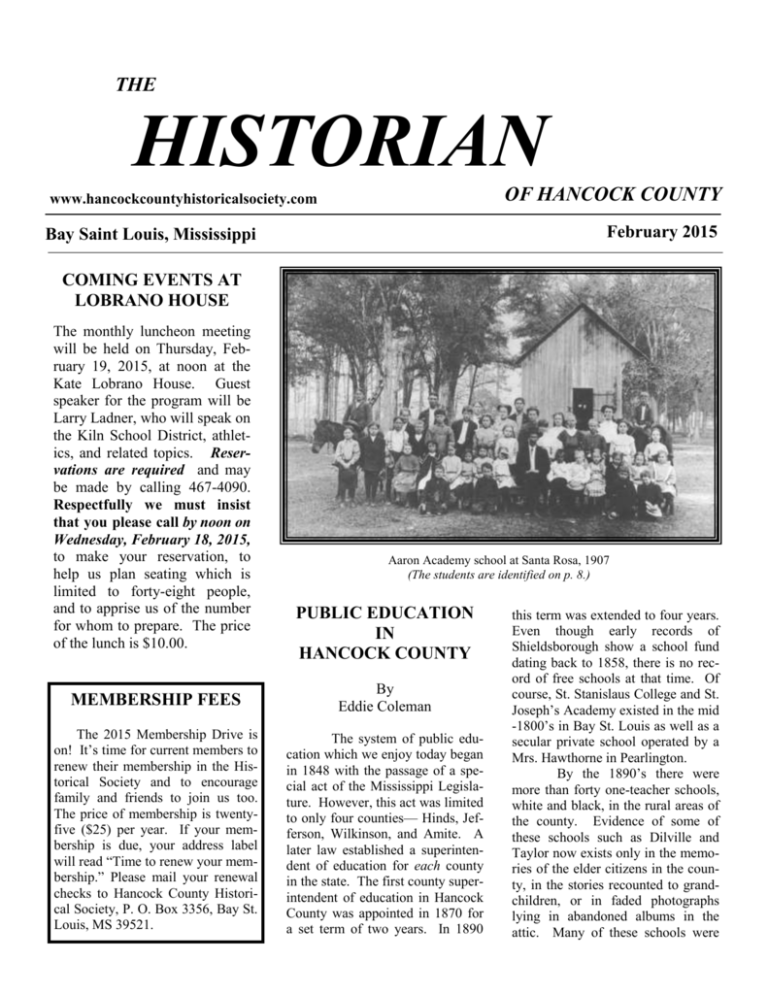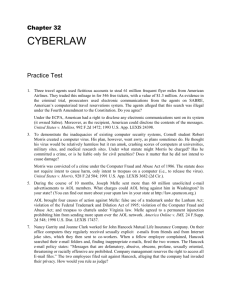
THE
HISTORIAN
OF HANCOCK COUNTY
www.hancockcountyhistoricalsociety.com
February 2015
Bay Saint Louis, Mississippi
COMING EVENTS AT
LOBRANO HOUSE
The monthly luncheon meeting
will be held on Thursday, February 19, 2015, at noon at the
Kate Lobrano House. Guest
speaker for the program will be
Larry Ladner, who will speak on
the Kiln School District, athletics, and related topics. Reservations are required and may
be made by calling 467-4090.
Respectfully we must insist
that you please call by noon on
Wednesday, February 18, 2015,
to make your reservation, to
help us plan seating which is
limited to forty-eight people,
and to apprise us of the number
for whom to prepare. The price
of the lunch is $10.00.
Aaron Academy school at Santa Rosa, 1907
(The students are identified on p. 8.)
PUBLIC EDUCATION
IN
HANCOCK COUNTY
MEMBERSHIP FEES
By
Eddie Coleman
The 2015 Membership Drive is
on! It’s time for current members to
renew their membership in the Historical Society and to encourage
family and friends to join us too.
The price of membership is twentyfive ($25) per year. If your membership is due, your address label
will read “Time to renew your membership.” Please mail your renewal
checks to Hancock County Historical Society, P. O. Box 3356, Bay St.
Louis, MS 39521.
The system of public education which we enjoy today began
in 1848 with the passage of a special act of the Mississippi Legislature. However, this act was limited
to only four counties— Hinds, Jefferson, Wilkinson, and Amite. A
later law established a superintendent of education for each county
in the state. The first county superintendent of education in Hancock
County was appointed in 1870 for
a set term of two years. In 1890
this term was extended to four years.
Even though early records of
Shieldsborough show a school fund
dating back to 1858, there is no record of free schools at that time. Of
course, St. Stanislaus College and St.
Joseph’s Academy existed in the mid
-1800’s in Bay St. Louis as well as a
secular private school operated by a
Mrs. Hawthorne in Pearlington.
By the 1890’s there were
more than forty one-teacher schools,
white and black, in the rural areas of
the county. Evidence of some of
these schools such as Dilville and
Taylor now exists only in the memories of the elder citizens in the county, in the stories recounted to grandchildren, or in faded photographs
lying in abandoned albums in the
attic. Many of these schools were
Page 2
THE HISTORIAN OF HANCOCK COUNTY
THE
HISTORIAN
OF HANCOCK COUNTY
Eddie Coleman, Editor
Ellis Cuevas, Publisher
Published monthly by the
HANCOCK COUNTY
HISTORICAL SOCIETY
2014 BOARD OF DIRECTORS
Charles Gray, Executive Director
John Gibson, President
Jim Thriffiley, First Vice President
Christina Richardson, Second Vice President
Lana Noonan, Secretary
Georgie Morton, Treasurer
Ellis Cuevas, Publicity
Jackie Allain, Historian
Ames Kergosien, Member at Large
MAILING ADDRESS:
P. O. Box 3356
Bay Saint Louis, Mississippi 39521
PHYSICAL ADDRESS:
108 Cue Street
Telephone/Fax
[228] 467-4090
Email address:
hancockcountyhis@bellsouth.net
Website:
www.hancockcountyhistoricalsociety.com
Marianne Pluim, Webmaster
poorly maintained with meager facilities according to an interview
with Mr. W. W. Stockstill conducted in March 1937 as part of the
Works Progress Administration
(WPA) program. Mr. Stockstill
served as Hancock County Superintendent of Education from 19001908.
In the early years of education in Hancock County, small
schools were established in the various communities throughout the
county. Some people remember
Gainesville, Turtle Skin, Dead
Tiger, Gravel Pit, Catahoula, and
Bagget schools. There was also a
provision made for an Indian school
in 1884 near the Indian settlement
at Bayou LaCroix. This school operated as late as 1895.
In February 1937 Mr. John
Craft, who served as Hancock
County Superintendent of Education from 1908-1920, was interviewed by Edmond J. Giering, who
worked on the WPA. Project. The
following information has been
gleaned from that interview.
Mr. Craft considered the
most outstanding achievement of
his administration to be the consoli-
dation of the county schools. Prior
to 1908 there were no definite district lines for the various schools in
the county, so the school board authorized that a new map be drawn
and new districting be made of the
schools. Pearl River and Harrison
Counties had already reorganized
and consolidated many of their
schools along these lines, and to
keep pace with the rapidly developing educational activity in the state,
Hancock County followed suit. At
that time, the county school board
was composed of Asa S. Weston of
Logtown, Beat 1; Wiley Smith, Picayune, Beat 2; Price W. Lee, Caesar, Beat 3; W. A. Cuevas, Fenton,
Beat 4; and George Hicks Edwards,
Bay St. Louis, Beat 5. In addition
to joining in the educational progress of the state, the most notable
advantages of this reorganization
were better health conditions, improved rural life activity, and more
professionally trained rural teachers.
Consolidation brought better health conditions in the form of
more comfortable school furniture
and improved sanitary facilities
with the installation of water cool-
LOBRANO HOUSE
HOURS
MONDAY — FRIDAY
10:00AM — 3:00PM
Closed: 12:00—1:00 (lunch)
MISSION STATEMENT
“TO PRESERVE THE GENERAL
AND ARCHITECTURAL HISTORY
OF HANCOCK COUNTY AND TO
PRESERVE THE KATE LOBRANO
HOUSE
AND
COLLECTIONS
THEREIN; TO RESEARCH AND INTERPRET LIFE IN HANCOCK
COUNTY; AND TO ENCOURAGE
AN APPRECIATION OF AND INTEREST IN HISTORICAL PRESERVATION.”
Dil-
ville
School Children (1920)
Hancock County, Mississippi
THE HISTORIAN OF HANCOCK COUNTY
ers, individual drinking cups, and
better toilet facilities. Improved
rural life activity came in the form
of a better knowledge of beautifying the school grounds as well as
the introduction of conveniences in
the home to make life in rural
school communities more attractive.
More professionally trained teachers came in the form of placing
some educational requirements on
teachers such as more professional
education.
The chief objection to consolidation was, as usual, increased
taxation, but the objection was
overcome through the diligent efforts of the county superintendent
and other interested citizens. The
Sellers School was formed out of
the Crane Creek, the Cap Ladnier,
and parts of the Standard schools in
the fall of 1914 and officially became the Sellers Consolidated
School. In 1915, the Dedeaux Line
School was formed out of Dedeaux,
Sand Hill, Orphan Creek, and part
of Standard. The Kiln Consolidated
School, which embraced a large
John Craft,
Hancock County Superintendent of
Education, 1908-1920
Page 3
Napoleon School,
Hancock County, MS, 1920
(The students are identified on p. 8.)
taxing unit, was formed from the
Necaise, Fenton, McLeod, Silver
Hill, and Bayou Talla schools in
1916. With over four hundred students the first year, it was one of the
largest consolidated schools in the
state and was proclaimed by the
state superintendent of education to
be one of the outstanding units of
consolidation. Two years later in
1918, the Lakeshore School was
formed out of the Clermont Harbor,
Ansley, and Lakeshore areas. By
the end of 1919, the number of oneteacher schools in the county had
been reduced by more than onehalf.
In 1937 when the WPA
Research Project was written, there
were fifteen elementary schools in
the county for the education of both
black and white students. There
were also four consolidated high
schools in Hancock County. At this
time the practice of “Separate, but
Equal” was prevalent throughout
the state, and the high schools appear to have been limited to white
students only. The schools located
in Beat 1 were the Logtown School
and the Gainesville School for white
children and “The Point” in
Pearlington and the Gainesville Colored School for black children. All
of these schools offered instruction
through the eighth grade.
Aaron Academy is the only
school listed in the WPA report as
being in Beat 2 in 1937. It was a
grammar school located at the intersection of Highways 11 and 90.
In Beat 3 there were two
grammar schools, Leetown and
Catahoula, and two high schoolsCaesar High School and Kiln Vocational High School. Caesar, a line
school located partially in Pearl
River County and partially in Hancock County, offered classes from
primary through twelfth grades.
The Kiln Vocational High School
was a senior high school with a curriculum offering home science, music, and athletics. Since it was a
vocational high school, agriculture
students had an outside project such
as raising a bale of cotton, an acre
of corn, etc., in addition to regular
class work.
Beat 4 boasted two high
Page 4
THE HISTORIAN OF HANCOCK COUNTY
schools and four grammar schools
for black children. The high schools
were Sellers Vocational High School,
located on the northern line between
Harrison and Hancock Counties, and
Dedeaux School, another consolidated vocational senior high school also
situated on the Harrison and Hancock
County line several miles south of
the Sellers School. The schools for
black children were the Fenton, Catahoula, Jourdan River, and Bagget
Schools.
Edwardsville
School,
Gulfview School, and Clermont Harbor School were all found in Beat 5.
Edwardsville School was situated on
Bayou Choctaw; Gulfview School
was located at Lakeshore one mile
north of the seawall; and Clermont
Harbor School sat halfway between
the seawall and the railroad in Clermont Harbor.
Because of the changing demographics of Hancock County, later
consolidation of schools in the decades following the 1910’s has caused
many of these schools to be closed
and others opened. Even though they
currently exist only in the old stories
and legends handed down from parent to child, they have played a very
important part in developing the
character, vision, and aspirations of
the citizens of Hancock County.
SOURCE:
Giering, Edmond J. “Schools of Hancock
County, MS,”
Works Progress Administration. Washington, DC: US Printing Office,
1937.
THE RINGING OF
SCHOOL BELLS
Edited by
Eddie Coleman
In 1976 Jeanne Doby Williams, a retired teacher of the Hancock County School System, handwrote an account detailing her experiences of teaching in the county
schools from 1912 until her retirement in 1958. The following article
is excerpted from her narrative.
“ In the fall of 1912, I began
teaching in the public school of my
hometown, Pearlington. I was principal and teacher. My pupils numbered thirty-two from primer through
eighth grade. I had had two years of
helping my mother in her private
school in Pearlington. Then [I] attended the Tri-County Normal
Jourdan River Colored School
School in Wiggins, Mississippi, for
nine or ten weeks, then took [the]
teachers’ examination in the Bay St.
Louis Court House, and got [a] license to teach. [Because of] the Poitevent and Favre mill preparing to
close, people commenced moving
from Pearlington.
Before this,
Pearlington Public School had had
two teachers; now, with a decreasing
population only one would be needed. I applied and received the appointment.
“When cool weather came,
we used pot-bellied stoves that
burned wood. We had no janitor; the
trustees saw that wood was put in the
schoolyard. The larger boys kept the
wood boxes indoors filled with
wood. The older girls were assigned
days to sweep and dust. I lit the fires
and saw they were out before we left.
I also helped with sweeping and
cleaning. We had no play equipment
[except] marbles, balls, bats, etc., that
the pupils brought. In groups we
would play ‘Drop the Handkerchief’
and singing games. There were no
free books. Our books were bought
or handed down...or given by someone that could use them no longer.
“Lunchrooms
were
unknown. Most of the children [lived
within] walking distance from the
school and went home for their midday lunch. If it was a rainy day, they
did as I did every day— brought
their lunch. I enjoyed the sessions.
However, so many families were
moving or just waiting for Poitevent
and Favre to get their sawmill in
Mandeville built that I was in doubt
about accepting the school for the
next session.
“My mother closed her private school in Pearlington and accepted a position in Logtown Public
School. My younger brother attended Logtown School and used to drive
my mother back and forth in a horse
drawn buggy. A short distance nearer, [in] Gainesville, a one-teacher
THE HISTORIAN OF HANCOCK COUNTY
Jean Doby
Williams, teacher of 4th and 5th grades
at Kiln High School, 1918-1919
public school needed a teacher. I
accepted the position and rode with
my brother and mother. The school
was the ‘Bennett Special.’ It was a
small one-room building, not [nearly]
as nice as Pearlington School. I only
had twenty pupils, all grades. The
heater, janitor service, [and] play
equipment [were] the same as in
Pearlington, only this heater’s pipe
often smoked and fell down a few
times.
“After this session my family
moved to Mandeville. I did not go
with them. I spent the summer in
Hattiesburg at Mississippi Normal
College, now USM. I visited my
family when I left Hattiesburg, and
on the second day I was in Mandeville, I received a telegram from Mr.
John Craft, then county superintendent of Hancock, telling me there
was a position as primary teacher
open for me in Bayou Talla Public
School, near Kiln, Miss., and if I accepted he would assist in getting a
good place for me to board, and he
did. Although Bayou Talla School
was about one mile from Kiln, the
patrons and pupils did not seem to
mind the distance. Many lived at
Bayou Talla; so did I. I boarded a
short distance from the school.
“The school was two-story
and had three large rooms. The principal, a man, taught sixth, seventh,
and eighth grades upstairs. The intermediate teacher and I each had a
room downstairs. She taught the
fourth, fifth, and part of the third
grade. I had the beginners through
third grade. We had no heater problems; they were in good condition.
The desks were comfortable, and we
had tables and chairs for reading purposes. Our play equipment was not
very plentiful, but the larger boys and
girls had spacious grounds to play
outdoor games. The little folks spent
recess periods on the school’s front
porch or playing under shade trees.
The book situation was poor. It was
either buy new books or use ‘handme-downs’ other members of the
family had used. We had to bring
our lunch, teachers as well as pupils.
My classes sat at tables to eat, and I
sat with them. I would spread a tablecloth made from colorful feed
sacks on our reading tables.
“[The
next
September]
I...had the same room, same position,
but a larger salary. Before long rumors were in circulation about the
passage of the Consolidated School
Law of 1914. Many wide-awake
citizens of Kiln and vicinity listened
and visioned what an excellent location Kiln would be for a large, wellequipped school. Finally, in 1916 a
petition was circulated at Kiln, Fenton, and elsewhere for a consolidated
school district, which was endorsed
by over [125] taxpayers and electors
of the district. The petitions were
presented to the school board in due
time, [and] they were acted upon favorably, the result being a magnificent two-story building known as
Kiln Consolidated School. It was
formed by the following named
schools: Necaise, McLeod, Fenton,
Page 5
Silver Hill, and Bayou Talla, comprising a district of fifty-two square
miles. The building, together with
the equipment, cost ten thousand dollars.
“[During] the first session
large covered vans drawn by horses
were used to transport pupils that
lived far from the school. Later motor trucks were used; [they] were
faster and cheaper in the long run.
All the classrooms were spacious; so
was the auditorium; each [was] well
equipped. Mr. Vernon Asendale was
the first principal, and the first graduates in the new school [for the]191617 session were Etha Kergosien and
Edgar J. Doby, my youngest brother.
“Our next principal was Prof.
S. P. Powell. We were six classroom
teachers, a domestic science teacher,
and a music instructor. Mr. Powell
coached the boys’ ball games. One
of the classroom teachers taught
manual training to her boys that were
in the sixth grade. Later when the
older girls wanted a basketball team,
Mr. Powell was their coach. Kiln
pupils took active parts in ballgames
[and] field meets in Hancock County
[and] also in neighboring counties.
Pupils who wished to do so took piano lessons.
“[In the] 1918-19 session 4H Club work was introduced in the
school under the guidance of Miss
Sallie Cirlot, County Home Demonstration Agent and Mr. Frank Pittman
as [county] agent. The school was
carefully watched and cared for by
the County Health Doctor, D. M.
Shipp, and the nurses who assisted
him. They lived in Bay St. Louis,
but visited often.
“Every room had adjustable
steel sanitary desks, charts, maps,
blackboards, and other necessary
school apparatus. We had electricity
throughout the school even to ring
the bell. We had a maintenance man
and janitor, sanitary drinking fountains, and indoor restrooms. For rec-
Page 6
THE HISTORIAN OF HANCOCK COUNTY
Sellers High School
Hancock County, MS
reation there were swings, slides, and
ball equipment of all kinds.
“In 1918-19 the teachers prepared a little volume Kiln Consolidated School and dedicated it to the
children of Hancock County. By this
time the school’s enrollment had
reached [350]. The patrons were
proud of their school; so were the
teachers and pupils. The 1919 graduates were four in number: Jessie
Cuevas, Mae Mauffray, Delia Beech,
and Lottie Cuevas.”
Did You Know This about
Hancock County?
Cotton
By
Scott Bagley
Did you know that Hancock
County at one time had a fairly sizeable cotton economy supported to a
large extent by slave labor? While
coastal Mississippi has not traditionally been associated with cotton
fields and slaves, for a period of time
Kiln High School
Kiln, MS
prior to, during, and just after the
Civil War, cotton was grown in Hancock County and sold both nationally
and internationally.
Before 1837 Mississippi’s
principal crop had been corn rather
than cotton with some rice rather
than corn grown in coastal areas such
as Hancock County. But cotton was
also grown and sold. Some of the
early cotton in the county was grown
on small farms along the lower Pearl
River, but it was most abundant
north of the 31st parallel.
Cotton grown along the Pearl
River was floated down the river on
flatboats when the water was high
enough or transported by wagon to
the head of navigation, where a small
community known as Cottonport developed on a bluff overlooking the
river. The cotton was loaded onto
boats there and shipped downstream
to a gin at Simon Favre’s farm about
a mile above Pearlington. This location was originally known as Favreport, but later came to be called
“The Gin.” The gin was built and
operated by one of Simon Favre’s
sons.
There were plantations in
Hancock County during the nineteenth century, and some of them
produced cotton. For example, the
Cowan-Fields plantation, in the early
1800s at Cedar Point, was the first to
grow
cotton
successfully—
specifically Sea Island cotton. Gossypium barbadense, the botanical
name of this type, was to become the
most common species grown in Hancock County. Although the French
had first experimented with this tall
growing perennial variety elsewhere
on the coast as early as 1720, the
plants failed to survive frost. Cowan
-Fields’ experimentation therewith
was successful and the growth of this
hearty variety spread throughout
Hancock County and was to bring
substantially more money at market
than other cotton varieties grown
THE HISTORIAN OF HANCOCK COUNTY
Elmwood Manor
elsewhere in Mississippi.
Other notable plantations in
what was then Hancock County grew
Sea Island cotton as well. These included plantations in the Pearl River
area owned by the Proctor family,
J.F.H. Claiborne, and Major Andrew
Jackson, the adopted son of President
Andrew Jackson. The latter two
large farms were situated specifically
on Mulatto Bayou, a tributary of the
Pearl. Still others were the Carroll
plantation, the Neal Jourdan plantation on the lower Catahoula, the Daniells plantation, and the Saucier plantation of Bayous Phillips and La
Croix. Most, if not all, of these plantations relied on slave labor. J.F.H.
Claiborne had at least one hundred
slaves as did the large Farr plantation
located at Lott’s Creek about five
miles west of the present site of Picayune (then a part of Hancock County). The Proctor plantation relied on
thirty to forty slaves for their cotton
production. While Simon Favre had
fifty-seven slaves on a plantation that
he had bought sometime before 1813,
it cannot be confirmed that he grew
cotton.
As a proportion of the population, few whites in the county actually owned slaves while most slaveholders owned no more than five
slaves. Only a handful (the exceptions noted above) owned more than
five to eight slaves.
The 1830s and 1840s seem
to be the decades during which cotton made its greatest contribution to
the Hancock County economy.
County population growth of 42%—
from 1,962 in 1830 to 3,367 in
1840—would seem to correlate with
the growth of the cotton economy on
the Pearl River. A smaller 9%
growth rate during the following dec-
Page 7
ade would appear to indicate continuing growth in spite of the loss of population to the newly formed Harrison
County. Cotton, however, continued
to be grown and sold in Hancock
County through and beyond the Civil
War. In 1871 it is documented that
J.F.H. Claiborne sold his Sea Island
cotton for fifty cents a pound and
brought “...upon an average of three
times as much as the short staple cotton.” A short time earlier The
Gainesville Advocate reported that
“Hancock claims the finest specimen
of Sea Island cotton exhibited in the
Liverpool market last year. It was
grown on the plantation of Judge
Daniells.”
Eventually the lower price of
cotton grown on the more productive
Mississippi delta lands caused the
finer, more luxurious Sea Island cotton grown in and around Hancock
County to be less profitable. Thus,
cotton became less and less a part of
the economy. A number of serious
local planters moved to the delta area, which likely contributed to the
decrease in Hancock County’s population, from 3,672 in 1850 to 3,134 in
1860. Another reason that cotton
decreased in importance was the
Laurelwood
Home of J.F.H. Claiborne
Page 8
THE HISTORIAN OF HANCOCK COUNTY
emergence of the very profitable
timber industry in Hancock County—a subject for another day.
Today only the sites of the
old cotton plantations remain, having been replaced by new homes,
recreational space, rich archaeological sites, or nothing at all. While
cotton was never necessarily king in
Hancock County, it was, at least for
a time, a prince.
SOURCES:
Giardino, Marco, PhD. & Russell
Guerin.Early History of Han-
cock County, Mississippi, with
Emphasis on the Pearl River
Area.
Unpublished manuscript, c. 2004.
Scharff, Robert G. Louisiana’s Loss,
Mississippi’s Gain.
Lawrenceville, VA:
Brunswick
Publishing Corp., 1999.
VOLUNTEERS
The Board of Directors thanks
our volunteers for all of your hard
work. You are a valuable asset to
our society in managing and preserving the history of Hancock
County.
.
Jackie Allain
Ana Balka
Jim Canady
Arden Erickson
Sue Erickson
Russell Guerin
Al Molnar
Art Phillips
Shawn Prychitko
Patty Taylor
Beth Weidlich
Aaron Academy Students (p. 1)
The students in the picture have been identified as follows: L to R (front row kneeling)—Curtis McCarty, Toxie Craft,
Kenneth McCarty, Lorette McQueen;
L to R (on bench—Virgil Craft, Bertha Burks, Mable Kellar, Sedonia Kellar, Louisa Kellar, Ola Miller, Rev. Tom Gordon
[teacher] Asa McQueen, Ora McClure Effie McDuffy, Ester Mitchell, Grace McClure, Oakie Frierson
L to R (standing)—Ralph Craft, Morgan Frierson (on horse), George Frierson, John Craft, Wiley Frierson, Jim McDuffey,
Albert McQueen, William Burks, Felton Mitchell, Luther Frierson, Lula McQueen, Agnes Kellar, Eugene Craft, Charley Kellar,
Geneva Craft, Edwina Burks, Rose Kellar, Geneva Frierson, Ruby Frierson, Leona McQueen, Orna Crusae, Ellis Mitchell (on
horse), Olivia Kellar
These identifications were given to the Society with the newspaper article from which the photo was taken.
Dilville School Students (p. 2)
The students in the picture have been identified as follows: L to R (sitting)— Albert “Boy” Lusich, Eldon Moran, Jorday
Johnson, Verdie Johnson, Lillian Lusich, and Sarah Favre;
L to R (mid-standing)— Legier Lusich, Velma Zengarling, Herbert Zengarling, Claiborne Ladner, Rufus Lusich, and
Corine Lusich;
L to R (back-standing)— Luvinia Moran, Robert Zengarling, Clara Ladner, George Zengarling, and Arnevia Moran.
This information was provided to the society by Luther Ladner.
Napoleon School Students (p. 3)
The students in the picture have been tentatively identified as follows (but in no particular order) as Clifton Murphy, Dorothy Hover, Gladys Miller, Louise Dawsey, Rose Dawsey, Lena Pearl Miller, Edith Hover, Hilary Odom, Ammon Kennedy
(kneeling), Prentiss Kennedy (kneeling), Johnnie B. Hover, Charles Miller, F.B. Blackmon, Earl Holden, Irene Eckerds [teacher],
Bell Holden, Edna Blackmon, Dora Hover, Eharmon Landrum, Ruby Blackmon, Edd Holden, Mittie Landrum, Myrtle Miller, Malissia Hover, Wilbert Odom, Minnie Dawsen, Ollie Murphy, Ethnal Davis, August Holden Cliff Dawsey
NEW MEMBERS
Jasper and Martha Fisher
Alton, IL
Earl and Rebecca Ladner
Bay Saint Louis, MS
Diane Seal
Thousand Oaks, CA
Judy Pritchard
Bay Saint Louis, MS
Steven Ypma and Ana Balka
Kiln, MS
Russell Guerin
Beth Weidlich
THE HISTORIAN OF HANCOCK COUNTY
Page 9
The Sisters: Ten Days in Sicily
(Sisters Series)
By L.L. Lee
A humorous, mystery novel set in
Louisiana, post-Katrina Bay Saint
Louis, and Sicily.
Available at Bay Books, Amazon.com,
Kindle
Contact Lee3731@bellsouth.net or
Amazon.com/author/lllee
OPEN SUNDAYS
HANCOCK LEGENDS EXPLORED;
FLESH PUT ON
SOME OLD
BONES.
BY
RUSSELL GUERIN
$29.95
228-463-2124
This book is a collection of stories
about Hancock
County, MS, and
some of its people,
including J.F.H.
Claiborne, Jean
Lafitte, Simon Favre, Andrew Jackson, Jr., Asa Russ,
and Christian Koch.
Page 10
THE HISTORIAN OF HANCOCK COUNTY
Steve B. Treutel
Senior Financial Advisor
Mississippi Gulf Coast
(228) 385-6307
Merrill Lynch Wealth Management makes available products and services offered by Merrill Lynch,
Pierce, Fenner & Smith incorporated, a registered broker-dealer and member SIPC, and other subsidaries of Bank of America Corporation. All rights reserved.
AD-06-12-0048
ARSOT2V1-10-11
Code 453007PM-0612
MANIERI
REAL
ESTATE,
LLC
CALL:
SESSIE
MANIERI
228-2162628
Secluded 1850 Restoration. Historic charmer on over 3 acres
in Pearlington, MS. Finish kitchen, bath, & second level bonus
for a total of about 1600’ living space. Wood walls, 10.5’
wood ceilings and hardwood floors.
SIXTH EDITION—(EDITIONS 1-5 SOLD OUT)
PLACE YOUR AD HERE.
BUY: AL SAUCIER.COM VENDORS
BAY BOOKS: 228-463-2688
KILN
MOONSHINE: Secret Nationwide Delivery Map
READ! ESCAPE! ENJOY!
SUPPORT YOUR HISTORICAL SOCIETY
$25.00
$20.00
$20.00
$20.00
$30.00
BOOKS BY
PAUL LAVIOLETTE AVAILABLE AT THE HANCOCK
COUNTY HISTORICAL
$20.00
THE HISTORIAN OF HANCOCK COUNTY
Page 11
305 Main
www.vrbo.com (ID #313124 & 400259)
P. O Box 3567
Bay Saint Louis, MS
228-466-4793
HANCOCK COUNTY HISTORICAL SOCIETY
P. O. BOX 3356
BAY ST. LOUIS, MS 39521
NON-PROFIT
ORGANIZATION
U. S. POSTAGE PAID
PERMIT NO. 87
BAY ST. LOUIS, MS
HANCOCK COUNTY HISTORICAL SOCIETY
POST OFFICE BOX 3356
BAY ST. LOUIS, MISSISSIPPI 39521
MEMBERSHIP APPLICATION
NAME ____________________________________________________________________________
ADDRESS _________________________________________________________________________
CITY, STATE AND ZIP ____________________________________________________________]
PHONE (_____)_______________________________
Email address___________________________________________________________________
ANNUAL DUES: HOUSEHOLD—$25; BUSINESS—$100 $__________









